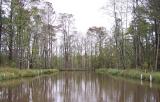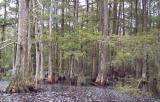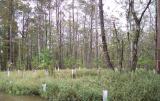Hydrologic Restoration and Vegetative Planting in the Des Allemands Swamp
The EPA-sponsored Hydrologic Restoration and Vegetative Planting in the Des Allemands Swamp project (BA-34-2) was the first swamp restoration project funded under the Coastal Wetlands Planning, Protection and Restoration Act (CWPPRA).
Mobilizing and dredging to restore a marsh (which is usually the focus of CWPPRA projects) is often very expensive. In comparison, hydrological restoration projects like the Des Allemands Swamp project can be constructed efficiently and cost effectively, resulting in higher cost benefit ratios.
In addition, swamps, especially mature cypress and tupelo trees, provide a level of protection against hurricanes and tropical storms that marsh creation cannot.
A Dying Swamp
Before CWPPRA’s involvement, a long series of events in the Lac des Allemands River Basin negatively impacted the swamp, which was on a path to marsh and open water. The area was cut off from the natural flow of water, largely caused by human activities over time, including the addition of levees, undersized culverts, and spoil banks. This condition is called "impoundment."
Efforts were made to relieve the impoundment, including installing culverts; however, the area couldn’t drain completely and connect to Bayou Chevreuil. The trees in the swamp were dying and not regenerating themselves.
Project Design
This project is located west of Lac des Allemands in St. James Parish and south of the town of South Vacherie. It is bordered on the south by Bayou Chevreuil and on the east by Louisiana Highway 20.
Initially, the concept was to provide freshwater from the Mississippi River into the swamp. However, modelling and cost estimates showed the siphon was not feasible. Therefore, in order to restore what took decades to degrade, CPRA engineers designed a plan to clear and excavate historical gaps in the existing banks that bordered Bayou Chevreuil.
Site topography and field survey information was reviewed and hydrologic modeling conducted so that CPRA engineers could strategically position the gaps.
Construction
The construction contractors removed heavy vegetation to clear the space. Next, the engineered gaps were excavated and the excess soil was spread as a thin layer in the immediate vicinity. This portion of the project effectively reconnected the swamp to the bayou.
Benefits
Repairing the area’s natural hydrology improved the health of existing trees by providing needed periods of flooding and drying. To jump-start the process, an additional 300 water tupelo and 900 bald cypress trees were planted. This final piece of the restoration project stabilizes the soil and helps replace dying mature cypress and tupelo trees. Construction of this project took about 5 months at a cost of just over $500,000. This project enhanced 2,395 acres of swamp habitat that would have otherwise continued to degrade.
According to Gary Shaffer, Professor of Biological Sciences at Southeastern Louisiana University, benefits were not anticipated for several years. However, researchers measured statistically significant regeneration within the first year.
Partners
EPA is proud to be the CWPPRA federal sponsor of the Hydrologic Restoration and Vegetative Planting in the Des Allemands Swamp project. We would like to thank our project partners including St. James Parish, the Barataria-Terebonne National Estuary Program and the Louisiana Coastal Protection and Restoration Authority.
Learn more about CWPPRAExit. Learn about other EPA-Sponsored CWPPRA Projects.



